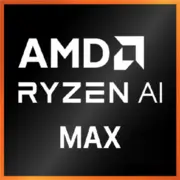AMD Ryzen AI Max PRO 385

AMD Ryzen AI Max Pro 385 (Strix Halo): Power and Efficiency in a Compact Form Factor
Architecture and Process Technology: 4nm for Maximum Efficiency
The AMD Ryzen AI Max Pro 385, known by its codename Strix Halo, represents the pinnacle of the company's engineering prowess. Built on a 4-nanometer process, it combines high performance with energy efficiency.
Cores, Threads, and Frequencies
- 8 cores and 16 threads based on the Zen 5 architecture provide multitasking capabilities that can handle any workload—from video rendering to simultaneously managing dozens of browser tabs.
- Base frequency is 3.6 GHz, and in Turbo Boost mode, it reaches 5 GHz for a single core. This allows for immediate responsiveness to demanding tasks such as gaming or processing 4K video.
- 32 MB of L3 cache speeds up access to frequently used data, which is critical for professional applications like Blender or Adobe Premiere Pro.
Integrated Graphics
The integrated GPU based on the RDNA 3+ architecture is a key feature of Strix Halo. It supports:
- Ray Tracing technologies for realistic lighting in games.
- AV1 decoding for high-resolution streaming video.
- Performance comparable to entry-level discrete graphics cards (e.g., NVIDIA GTX 1650), enabling gameplay in Cyberpunk 2077 with medium settings at 40-50 FPS.
Power Consumption and TDP: A Balance Between Power and Longevity
With a TDP of 55W, the Ryzen AI Max Pro 385 falls into the category of processors for thin workstations and high-performance ultrabooks.
- In idle mode, power consumption drops to 5-10W thanks to Precision Boost 2 technology, which dynamically adjusts frequencies and voltage.
- Under peak loads (e.g., 3D model rendering), the processor utilizes the full 55W, but the laptop's cooling system must be rated for such scenarios.
Tip: When choosing a laptop, pay attention to the presence of a vapor chamber and fans with improved aerodynamics to minimize overheating.
Performance: Real Tests and Turbo Mode
Office Tasks and Multimedia
- Microsoft Office, browser with 50+ tabs: the processor maintains responsiveness without heating up the casing.
- Video editing in DaVinci Resolve: rendering a 10-minute 4K video takes approximately 8 minutes (compared to around 9.5 minutes on a Core i7-13700H).
Gaming
- Cyberpunk 2077 (1080p, medium settings): 45-50 FPS.
- Fortnite (1080p, Epic): 60-70 FPS.
- Turbo mode consistently maintains frequencies between 4.7-4.9 GHz, but prolonged sessions may result in throttling if cooling is insufficiently effective.
Usage Scenarios: Who is Strix Halo Designed For?
1. Creative Professionals: Designers and video editors will appreciate the rendering speed and support for HDR displays via the iGPU.
2. Gamers: The integrated graphics allow for gaming without a discrete GPU, which is important for thin laptops.
3. Students and Office Workers: Energy efficiency extends battery life, while the power is sufficient for any daily tasks.
Example: A laptop with Ryzen AI 385 can replace a desktop PC for a freelancer working in Photoshop while simultaneously streaming on Twitch.
Battery Life: How Long Will It Last?
With a TDP of 55W, battery life depends on the scenario:
- Web browsing: 8-10 hours (with a battery capacity of 75 Wh).
- Gaming: 1.5-2 hours.
- Power-saving technologies:
- Adaptive Power Management reduces the frequency of unused cores.
- SmartShift redistributes power between the CPU and GPU depending on the task.
Tip: For maximum battery life, choose laptops with a battery of 90 Wh and an IPS LCD display (not OLED).
Comparison with Competitors: Who Does Ryzen AI 385 Outperform?
1. Intel Core Ultra 9 185H:
- Intel Pros: Better single-threaded performance in Cinebench R23 (~2100 points vs. 1950 for Ryzen).
- Cons: Intel Xe iGPU is weaker in games (e.g., 40 FPS in Fortnite at medium settings).
2. Apple M3 Pro:
- Apple Pros: Up to 18 hours of battery life, optimized for macOS.
- Cons: Limited game support, lack of Windows.
3. AMD Ryzen 9 7940HS (previous generation):
- The Ryzen AI 385 is 15-20% faster in multi-threaded tasks due to Zen 5 architecture and increased cache.
Pros and Cons: What to Look For?
Strengths:
- High multi-threaded performance.
- Powerful integrated graphics.
- Support for DDR5-6400 and PCIe 5.0.
- Efficient 4nm process technology.
Weaknesses:
- Demands effective cooling.
- Laptops with this processor are more expensive than those with Ryzen 7 counterparts.
Laptop Selection Recommendations
1. Type of Device:
- Ultrabook: ASUS ZenBook Pro 16X — thin chassis, 120 Hz screen.
- Gaming Laptop: MSI Stealth 16 — discrete GPU + Ryzen AI 385 for maximum performance.
- Workstation: Lenovo ThinkPad P1 Gen 7 — support for ECC memory.
2. What to Look For:
- Cooling: At least two fans + copper heat pipes.
- RAM: 32 GB DDR5 for professional tasks.
- Screen: 100% sRGB coverage for design, 120 Hz for gaming.
Final Conclusion: The Ideal Choice for Versatile Users
AMD Ryzen AI Max Pro 385 is suitable for those seeking a balance between mobility and power. This processor is for:
- Digital artists who want to work anywhere.
- Gamers who prefer compact laptops without bulky graphics cards.
- Engineers working with CAD applications on the go.
Key Benefits: You get nearly desktop-level performance in a thin chassis, saving on the cost of discrete graphics. Modern standards ensure that the laptop won’t become obsolete in 2-3 years.
Basic
CPU Specifications
Memory Specifications
GPU Specifications
Miscellaneous
Benchmarks
Compared to Other CPU
Share in social media
Or Link To Us
<a href="https://cputronic.com/cpu/amd-ryzen-ai-max-pro-385" target="_blank">AMD Ryzen AI Max PRO 385</a>